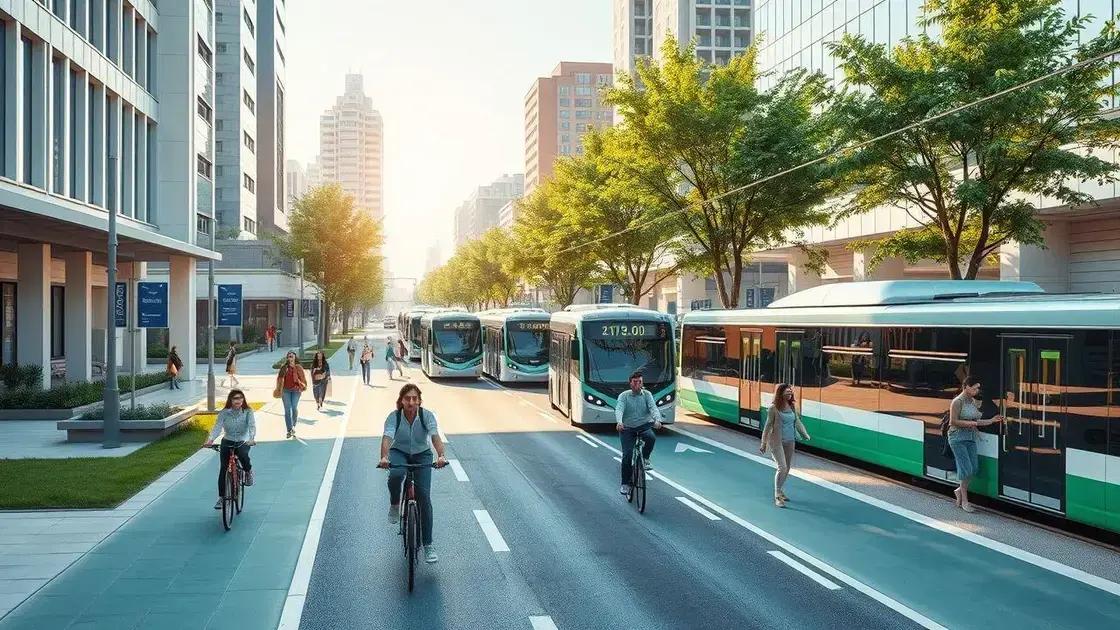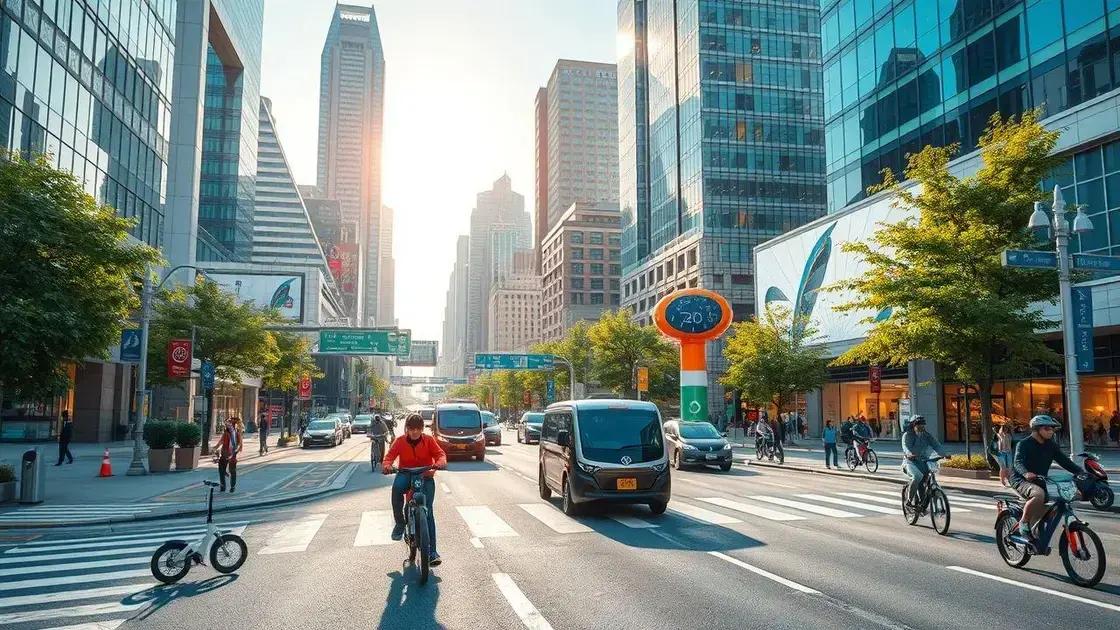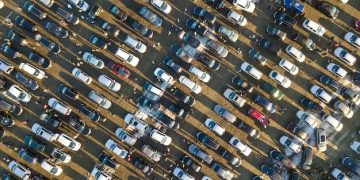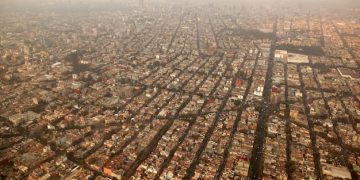Impact of remote work on commuting patterns and trends

The impact of remote work on commuting patterns has led to reduced traffic, improved air quality, and significant shifts towards sustainable urban transport solutions, enhancing overall urban living conditions.
The impact of remote work on commuting patterns has been vast, changing the way many of us think about daily travel. Have you ever considered how working from home affects your neighbor’s commute? Let’s dive into this evolving landscape.
Understanding remote work dynamics
Understanding the dynamics of remote work is essential in today’s rapidly evolving workforce. Remote work has transformed the way we collaborate, communicate, and manage our time. This shift has not only changed individual work patterns but also affected whole teams and organizations.
Key Features of Remote Work
Several characteristics define remote work. First, flexibility plays a significant role. Employees can often choose their hours and work environment. This level of control leads to enhanced productivity and improved work-life balance, making it an attractive option for many.
- Flexible schedules: Employees can work when they feel most productive.
- Reduced commute: Many remote workers save time and enjoy a less stressful day.
- Diverse locations: People can work from anywhere, such as cafes, homes, or co-working spaces.
Additionally, technology greatly influences how remote teams operate. Tools such as video conferencing, project management software, and instant messaging platforms allow for seamless collaboration. These advancements help maintain communication among team members and facilitate project management, despite physical distances.
Challenges in Remote Work
Despite its many benefits, remote work comes with challenges. For instance, maintaining team cohesion can be difficult. When employees are dispersed, fostering a strong company culture requires intentional efforts. Employers must find creative ways to keep their teams connected and engaged.
Another challenge is the potential for distractions at home. Many remote workers might face interruptions that can affect productivity. Establishing a dedicated workspace can help minimize these distractions and enhance focus.
- Overcoming distractions: Creating a specific work area can help.
- Building connections: Regular virtual meetings can strengthen team relationships.
- Time management: Setting boundaries helps maintain a healthy work-life balance.
Ultimately, understanding remote work dynamics requires recognizing both its advantages and pitfalls. By effectively navigating these changes, organizations can foster a productive remote work environment that keeps employees engaged and satisfied.
Adapting to a remote work culture means continuously evolving and learning. As businesses embrace this new normal, they will likely find innovative ways to support their teams and navigate challenges.
Shifts in commuting habits

Shifts in commuting habits have been greatly influenced by the rise of remote work. As more people opt to work from home, we are witnessing significant changes in how and when individuals travel to their workplaces. Understanding these shifts is key to adapting to the new normal.
Changing Patterns
One of the most notable changes is the decreased need for daily commutes. Many employees now enjoy working from home, which reduces their travel time significantly. This change leads to less congestion on the roads and public transport. There is also a shift in peak travel times. Unlike before, when morning and evening rush hours were the norm, many are now choosing to travel or conduct business at more flexible hours.
- Less daily commuting: Many workers have permanently shifted to remote setups.
- Flexible hours: Workers often commute outside traditional peak times.
- Public transport usage: Reduced reliance on public transportation systems.
Additionally, the types of transportation used are changing. With fewer people commuting daily, many are considering alternatives to traditional cars or buses. Biking and walking are becoming more popular among those who do need to commute. This trend not only supports better health but also reduces the environmental impact of transportation.
Environmental Impact
The decline in commuting also leads to positive changes for the environment. A significant reduction in vehicle emissions results from fewer cars on the roads. Cities are noticing cleaner air, as the volume of pollutants decreases. This trend creates opportunities for urban areas to promote sustainable transport solutions and infrastructure, further enhancing city life.
Moreover, many businesses are recognizing the benefits of this shift. By allowing more employees to work remotely, companies can reduce their operational costs. They are also helping to lessen traffic congestion, which creates a more efficient transportation network. As this evolution continues, organizations may rethink their strategies and policies regarding remote work.
Overall, the shifts in commuting habits reflect a broader change in our work culture. These changes contribute to a more sustainable and efficient way of living, as we adapt to the demands of modern work environments.
Environmental effects of reduced commuting
Environmental effects of reduced commuting have become a significant topic as more people embrace remote work. With fewer cars on the road, we can observe substantial improvements in air quality and a decrease in greenhouse gas emissions. This change not only benefits the planet but also enhances the quality of life in urban areas.
Cleaner Air Quality
As daily commuting decreases, harmful air pollutants also diminish. This shift leads to cleaner air in cities, promoting better health for residents. Studies show that reduced vehicle emissions lower the risk of respiratory illnesses and other health problems.
- Decreased smog: Fewer cars contribute to less haze and pollution.
- Healthier populations: People are less likely to suffer from air quality-related illnesses.
- Urban greenery: Cleaner air encourages city planning that includes parks and green spaces.
Moreover, reduced commuting leads to lower noise pollution in urban environments. Streets that were once filled with honking cars and idle engines are quieter, making city life more enjoyable. The serene environment encourages outdoor activities, creating a more vibrant community.
Decreased Greenhouse Gas Emissions
The reduction in commuting also results in a significant drop in greenhouse gas emissions. With less reliance on gasoline-powered vehicles, cities see improvements in their overall carbon footprints. This shift plays a vital role in addressing climate change by reducing the amount of carbon dioxide released into the atmosphere.
Furthermore, as organizations adapt to remote work, they often reconsider their office spaces. This shift can lead to downsizing or repurposing buildings, which can lower energy consumption, thus driving sustainability. Transitioning to energy-efficient technologies can further enhance these positive environmental effects.
In addition, public transportation services can redirect their focus. With fewer commuters, they can concentrate on improving existing services and promoting sustainable transport options, such as electric buses or bike-sharing programs. By investing in greener transportation, we create a sustainable future.
Future predictions for urban travel

Future predictions for urban travel are rapidly evolving as cities adapt to the changes brought by remote work. As more people work from home, the way we navigate urban spaces will continue to shift. These transformations will likely shape the future of transportation and urban planning.
Increased Use of Technology
Advancements in technology will play a significant role in urban travel. Smart transportation systems are beginning to emerge, allowing for better traffic management and public transportation options. Utilizing apps that provide real-time data can help commuters make informed decisions about their travel routes.
- Smart Traffic Lights: These can adjust based on traffic flow, improving efficiency.
- Rideshare Integration: Combining public transport with rideshare services will ease congestion.
- Autonomous Vehicles: Self-driving cars may become a common sight on city streets.
Moreover, electric vehicles (EVs) are expected to take over traditional gasoline cars, reducing emissions further. Urban planners may prioritize infrastructure that supports EV charging stations, making it easier for residents to switch to cleaner options.
Shift Towards Micro-Mobility
The rise of micro-mobility solutions, such as e-scooters and bicycles, will redefine short-distance travel in cities. These options are not only convenient but also contribute to reducing traffic and pollution. As more people opt for these alternatives, cities will need to invest in safe lanes and parking for micro-mobility devices.
Additionally, urban areas may redesign their layouts to encourage walking and cycling. Parks, pedestrian-only zones, and dedicated bike paths will become essential components of city infrastructure. These changes will make urban travel more enjoyable and sustainable.
Public transportation will also evolve to meet the changing needs of commuters. With a focus on health and safety, cities will implement measures to ensure social distancing and cleanliness in buses and trains. Enhanced sanitation protocols and the introduction of contactless payment systems will transform the public transport experience.
FAQ – Frequently Asked Questions about the impact of remote work on commuting and urban travel
How has remote work changed commuting patterns?
Remote work has reduced the need for daily commutes, leading to less traffic congestion and lower emissions.
What are the environmental benefits of reduced commuting?
With fewer cars on the road, we see cleaner air and a decrease in greenhouse gas emissions, contributing to better public health.
What technologies are transforming urban travel?
Smart transportation systems, electric vehicles, and micro-mobility options like e-scooters are improving urban travel efficiency.
How do public transportation systems evolve with these changes?
Public transport is adapting by enhancing safety, implementing contactless payments, and focusing on cleaner and more efficient service.





